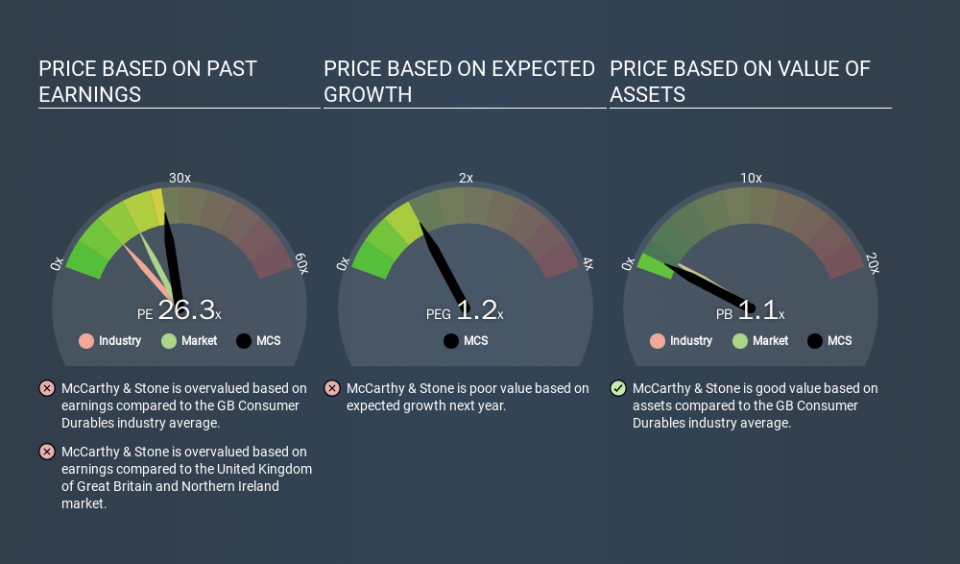What Does McCarthy & Stone plc's (LON:MCS) P/E Ratio Tell You?

This article is written for those who want to get better at using price to earnings ratios (P/E ratios). We'll apply a basic P/E ratio analysis to McCarthy & Stone plc's (LON:MCS), to help you decide if the stock is worth further research. McCarthy & Stone has a P/E ratio of 26.31, based on the last twelve months. In other words, at today's prices, investors are paying £26.31 for every £1 in prior year profit.
See our latest analysis for McCarthy & Stone
How Do I Calculate A Price To Earnings Ratio?
The formula for price to earnings is:
Price to Earnings Ratio = Price per Share ÷ Earnings per Share (EPS)
Or for McCarthy & Stone:
P/E of 26.31 = GBP1.47 ÷ GBP0.06 (Based on the year to October 2019.)
Is A High Price-to-Earnings Ratio Good?
A higher P/E ratio means that investors are paying a higher price for each GBP1 of company earnings. That isn't necessarily good or bad, but a high P/E implies relatively high expectations of what a company can achieve in the future.
Does McCarthy & Stone Have A Relatively High Or Low P/E For Its Industry?
We can get an indication of market expectations by looking at the P/E ratio. As you can see below, McCarthy & Stone has a higher P/E than the average company (12.7) in the consumer durables industry.
Its relatively high P/E ratio indicates that McCarthy & Stone shareholders think it will perform better than other companies in its industry classification. The market is optimistic about the future, but that doesn't guarantee future growth. So further research is always essential. I often monitor director buying and selling.
How Growth Rates Impact P/E Ratios
When earnings fall, the 'E' decreases, over time. That means even if the current P/E is low, it will increase over time if the share price stays flat. Then, a higher P/E might scare off shareholders, pushing the share price down.
McCarthy & Stone shrunk earnings per share by 33% over the last year. And over the longer term (5 years) earnings per share have decreased 12% annually. This growth rate might warrant a below average P/E ratio.
Remember: P/E Ratios Don't Consider The Balance Sheet
The 'Price' in P/E reflects the market capitalization of the company. Thus, the metric does not reflect cash or debt held by the company. In theory, a company can lower its future P/E ratio by using cash or debt to invest in growth.
Such spending might be good or bad, overall, but the key point here is that you need to look at debt to understand the P/E ratio in context.
So What Does McCarthy & Stone's Balance Sheet Tell Us?
The extra options and safety that comes with McCarthy & Stone's UK£27m net cash position means that it deserves a higher P/E than it would if it had a lot of net debt.
The Bottom Line On McCarthy & Stone's P/E Ratio
McCarthy & Stone trades on a P/E ratio of 26.3, which is above its market average of 18.3. Falling earnings per share is probably keeping traditional value investors away, but the healthy balance sheet means the company retains potential for future growth. If fails to eventuate, the current high P/E could prove to be temporary, as the share price falls.
When the market is wrong about a stock, it gives savvy investors an opportunity. As value investor Benjamin Graham famously said, 'In the short run, the market is a voting machine but in the long run, it is a weighing machine. So this free visual report on analyst forecasts could hold the key to an excellent investment decision.
But note: McCarthy & Stone may not be the best stock to buy. So take a peek at this free list of interesting companies with strong recent earnings growth (and a P/E ratio below 20).
If you spot an error that warrants correction, please contact the editor at editorial-team@simplywallst.com. This article by Simply Wall St is general in nature. It does not constitute a recommendation to buy or sell any stock, and does not take account of your objectives, or your financial situation. Simply Wall St has no position in the stocks mentioned.
We aim to bring you long-term focused research analysis driven by fundamental data. Note that our analysis may not factor in the latest price-sensitive company announcements or qualitative material. Thank you for reading.

 Yahoo Finance
Yahoo Finance 
